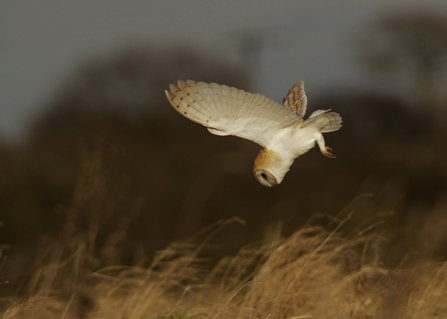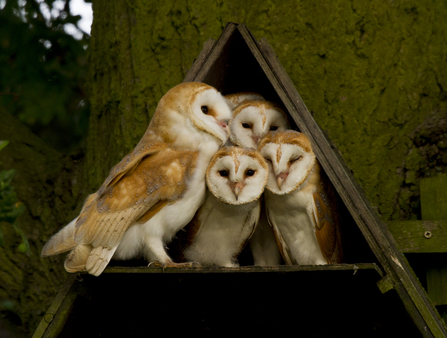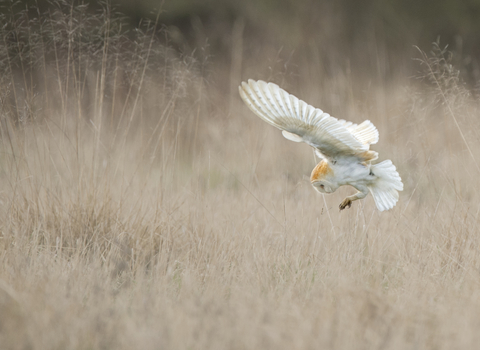The ghostly silhouette of a barn owl, seen silently floating over a meadow, marsh or field margin is a view of Suffolk’s landscape that many people treasure. But with the loss of habitat and nesting opportunities the breeding population had fallen below 100 breeding pairs in the county in 2005.
Working alongside the Suffolk Bird Group, Suffolk Wildlife Trust were involved with ‘Suffolk Community Barn Owl Project’ - a countywide initiative to install barn owl nest boxes and advise landowners about providing barn owl habitat. The project has been an overwhelming success and has helped restore the number of barn owls to levels not seen since the 1930s.
Under threat
From around 1945 barn owl numbers across the UK plummeted, with populations falling by almost 70% over 50-60 years. By the turn of the century, there were thought to be only 100-125 pairs in the county, mainly in north east Suffolk. It’s believed the dramatic decline of what was considered to be a common and well-distributed owl was caused by a combination of habitat loss and a shortage of viable nest sites.
With the outbreak of war came the intensification of farming techniques. Changes to the management of field margins, watercourses, hedgerows, woodland edges and even roadside verges meant that rough and long grassland - the owls’ favoured hunting site for voles, mice and shrews – became fragmented. It is estimated that since 1939 a hefty 96% of Suffolk's unimproved grassland has been lost.
A reduction in farmyard foraging by rodents due to improvements in the methods of handling grain and the lethal effects of organochlorine pesticides also took their toll. As food sources dwindled and hunting grounds shrunk, traditional nesting sites vanished as the number of hollow trees available were reduced by Dutch elm disease, ’tidying’ away dead trees, barns were sealed up, replaced with modern structures or converted into dwellings, and other causes.
The construction of major new road networks also hit owls hard. Not only did new highways fragment habitat, but faster traffic left owls flying along the verges looking for voles at hunting height unable to avoid collisions.
Habitat
Barn owl is predominately sedentary and site faithful – the same pair will use the same location year after year. With soft unwater-proofed feathers, which quickly become saturated in the rain, barn owl need sheltered nest sites, and roost sites for the male, to breed successfully. As one of the UK’s driest counties, Suffolk is a natural stronghold.
Suffolk’s open grassland habitats of meadows, marshes and the widespread adoption of grassy headlands on farms provide ideal hunting areas. Grassland needs to be rough, thick and tussocky with a deep litter layer to attract small mammal prey such as the short-tailed vole. This habitat allows barn owl to survive and breed as a typical family needs to eat around 10,000 vole sized small mammals every year in order to thrive.

Barn owl hunting - Russell Savory
Roads
Roads are by far the largest cause of barn owl mortality with accidents on minor roads killing young barn owls after they have fledged and major roads killing adult birds that survived fledging and dispersal. Whilst this can be partially remedied by growing tall hedges as a boundary between busy roads and barn owl hunting habitat, it is difficult to completely block off roads to barn owls because of the practicalities of having gaps in the hedge such as gateways where barn owls will naturally swoop low through.
The primary consideration when siting a barn owl nest box is whether the fledgling and hunting barn owls will be safe from road traffic. It is best to avoid siting a barn owl nest box overlooking a road as the barn owl will swoop low over the road to fly to and from the nest box. The risk of mortality in mature birds can be reduced by avoiding siting a barn owl nest box within one kilometre of a motorway or dual carriageway.
Nest boxes
Although barn owls have been severely affected by the loss of mature trees and agricultural buildings, fortunately they take readily to nest boxes and through an intensive nest box installation and monitoring programme since 2006, Suffolk Community Barn Owl Project (SCBOP) has helped transform the fortunes of barn owl in Suffolk.
When siting nest boxes good quality barn owl hunting habitat is crucial to ensure the box will be viable for barn owl breeding success. Good habitats for barn owls to hunt include open grassland, marsh, meadow, river corridors and arable field margins.
Supported by a network of trained volunteers, SCBOP installed more than 1,700 barn owl boxes across the county. The project has resulted in barn owls now being seen in places where they were missing for generations, having spread from their stronghold in north east Suffolk into central and western Suffolk. According to a monitoring by SCBOP volunteers, the numbers of breeding pairs quadrupled from 108 breeding pairs in 2007 to 427 in 2012. In 2017, volunteers monitored 78% of the 1,774 nest boxes and logged the presence of barn owls in 469 of them.

Barn owl family in box - Russell Savory
Nest box design
A poorly designed barn owl nest box will cause the death of barn owl chicks before they are ready to fledge – largely due to the chicks falling out of the nest box. If a barn owl chick falls to the ground the adult barn owls will not feed it here and it will die of cold or starvation.
The chicks usually fall out of nest boxes because the positioning of the entrance hole is too low resulting in barn owls being pushed by siblings or falling out of the nest box before they are actually ready to fledge.
This common problem can be simply solved by ensuring that the nest box is of a deep design with the entrance hole in the top of the nest box with a landing platform outside the entrance hole.
This ensures that chicks only leave the box when they are ready and able to do so and the landing platform on the outside of the box helps fledglings to gain their flying skills by practicing flying to and from the nest box.
Barn owl advice
If you would like advice on managing your land to benefit barn owls please check out our Wilder Landscapes page here Wilder landscapes | Suffolk Wildlife Trust.

